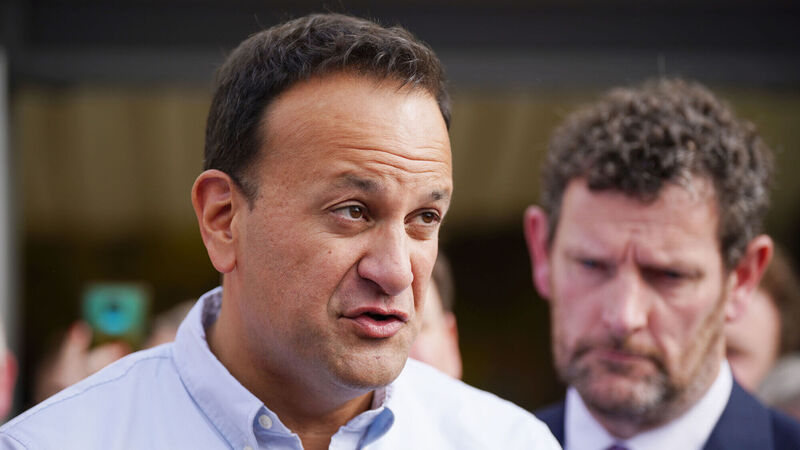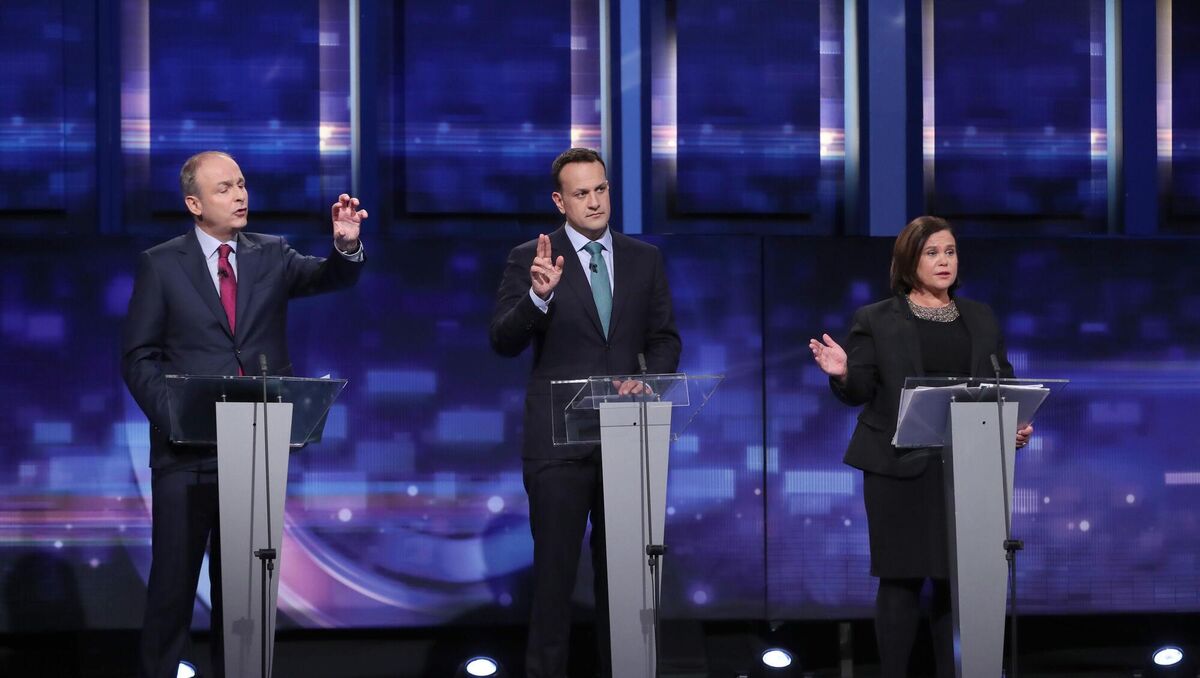Leo Varadkar and the evolution of Fine Gael

Tánaiste Leo Varadkar and Fine Gael MEP Colm Markey at the National Ploughing Championships at Ratheniska Co Laois, in September. Picture: Niall Carson/PA Wire
The decisions he makes in exactly four weeks’ time will be crucial.
Fine Gael members meet in Athlone this weekend for the party’s ard fheis and they will be listening carefully to what he has to say on future moves.
From his arrival in Leinster House in 2007, Leo Varadkar was marked out as special.
The young medical doctor turned councillor and then TD was straight-talking and was immediately appointed to the Fine Gael front bench.
Despite this preferment, the young Varadkar was not a major fan of his then leader and future taoiseach Enda Kenny.
As the Irish economy crashed, Varadkar emerged as one of the true leading lights of the 30th Dáil, and wasn’t afraid to slay sacred cows.
Most notably, he drew much internal criticism when he sought to denounce Brian Cowen’s economic legacy by likening him to the iconic Fine Gael leader Garrett FitzGerald, who he said “doubled the national debt”.

Varadkar, along with his close ally Lucinda Creighton, was a leading member of the botched heave against Kenny in 2010, and in typical Varadkar fashion delivered the most devastating quip about his party leader.
“I have had to ask myself that key question, the 3am question, if we are in government and there is a national crisis, if there is a sovereign debt crisis for example and [then Governor of the Central Bank] Patrick Honohan rings the Taoiseach — who do I want to answer that phone, I want Richard Bruton to answer that... The people are saying to us they don’t have confidence in Enda Kenny.”
Kenny survived the challenge and eight months later found himself in office as taoiseach heading up a coalition of Fine Gael and Labour, which commanded the largest majority in the history of the State.
Despite his opposition of Kenny, the taoiseach appointed Varadkar minister for transport, tourism and sport.
In 2014, Varadkar broke ranks with his Cabinet colleagues, especially then justice minister Alan Shatter, in the midst of the Garda whistleblower crisis when he disputed comments made by then Garda Commissioner Martin Callinan that the actions of said whistleblowers were “disgusting”.
Following the 2014 local and European elections, Kenny moved Varadkar to the challenging brief of Health, where his record at best was mixed.
He came out as gay in an interview with broadcaster Miriam O’Callaghan on her Sunday morning show.
He said: “It’s not a big deal for me any more. I hope it’s not a big deal for anyone else — it shouldn’t be.”
A few months later, Ireland voted in a referendum to legalise same-sex marriage.
When Kenny announced his retirement as taoiseach and Fine Gael leader, Varadkar and his team of supporters launched a “shock-and-awe” strategy, which saw most of the party’s parliamentarians endorse him within the first 48 hours to some controversy.
He caused further controversy when he argued Fine Gael should represent those “who got up early in the morning”.
On his election as Fine Gael leader, addressing the huge crowd in Dublin’s Mansion House Round Room, Varadkar said his victory showed the world that prejudice holds no place in Ireland in 2017.
Varadkar’s honeymoon period extended into 2018 when his approval ratings hit 60%, which a number a news reports at the time called “Bertie Ahern proportions”.
Heading into that summer, he was riding high having called a referendum on the Eighth Amendment which was passed by a massive majority and saw Fine Gael’s polling rise to 34%.
But that summer’s European elections would trigger no fewer than four by-elections and despite Fine Gael’s high polling heading into the November 29 showdowns — just seven days out the party had 34% of support — none of the contests returned a Fine Gael TD.
Party insiders at the time were able to wave away the results by contending that, in reality, it was one loss since three of the seats were held by the opposition anyway.
They argued Emer Higgins’ loss to Mark Ward was the only real defeat for Varadkar because the seat had been filled by Frances Fitzgerald. They added that Higgins had shown she could win a seat in a general election, which she went onto do a few months later.
Fine Gael members pointed to the historically poor performances of sitting governments in by-elections and said with a general election looming, the Government was likely to get a hit from the electorate.
But some pointed to Varadkar’s handling of a controversy in the Wexford by-election when Fine Gael candidate Verona Murphy suggested asylum seeker children as young as three years of age need to be “deprogrammed” as they may have been manipulated by Isis.
The then-taoiseach said Murphy had got it wrong, but he would still be campaigning with her before her eventual loss. The fact Murphy was able to take a seat in the 2020 general election as an independent was particularly galling for some in the party.
That election is characterised by some who ran in it as “one that never got going” or that was “stuck in the mud”. One party source says the election made Fine Gael, in government since 2011, seem “tired”. Another says that the party “had little to offer” a public which wanted change. The result was an anaemic campaign and the loss of about a quarter of the party’s seats.
However, despite the result, there was no time for Fine Gael members to consider their party leader’s standing as the pandemic hit. Indeed, that crisis increased both Varadkar and Fine Gael’s popularity until after the government was formed.
Party members believe Varadkar “struggled” in his role as Tánaiste, having been the leader of the nation in crisis-time but polling and internal opinion remained high, even as Varadkar’s close friend Eoghan Murphy resigned his post as TD, leading to another by-election and another electoral defeat for the Tánaiste as Labour’s Ivana Bacik took the seat in Dublin Bay South.
It was quite obvious from the get-go that Varadkar would struggle to step back from the limelight and allow Micheál Martin to become number one.
Having been successful in the initial stages of Covid-19 while announcing the first lockdown from Washington DC, Varadkar created a lot of headaches for the coalition Government later in the pandemic.
He sought to upstage Martin and other Fianna Fáil Cabinet ministers by jumping in and making announcements in order to get the kudos, which infuriated the other two parties.
Frustrations with Varadkar’s actions were aired weekly at Fianna Fáil parliamentary party meetings and he soon began to face criticism within his own ranks, with TDs hitting out that the Government did not seem to be on the same page with their messaging.
This was amplified further when Varadkar went on and berated the National Public Health Emergency Team (Nphet) for blindsiding the Government with its level 5 lockdown recommendation in October 2020.
It was an extraordinary moment during the pandemic and a very public dismissal of the then-chief medical officer, Dr Tony Holohan.
Varadkar slapped down the public health recommendation, stating it was not “thought through” and his comments undoubtedly damaged the authority of Nphet during a time when public buy-in was required to suppress the virus.

In an interview with this newspaper, the Taoiseach highlighted tensions between both leaders by admitting he sometimes counted to 10 before dealing with his coalition partner.
Varadkar’s time as Tanáiste has probably been the most difficult period in his career yet.
There is no question the Garda investigation into his leaking of a draft Government document to a friend in 2019 has harmed his reputation.
Although he did not break any law, the investigation itself, the admission that he did pass a document to a friend while taoiseach and having to make an apology in the Dáil was disastrous and awarded him the nickname ‘Leo the Leak’ which he will likely never shake off.
The episode lost him support within his own party as well as the electorate and as a result of his actions placed his party colleagues in the firing line of questioning on the matter every time they were interviewed.
As Minister for Enterprise, Trade and Employment, Varadkar is overseeing the brief at a time when employment is at an all-time high.
He has introduced legislation to enhance workers’ rights such as tipping legislation as well as sick pay to all Irish workers for the first time in Ireland.
However, his remote working bill was a dud and had to be completely revamped after intense criticism it was stacked in favour of employers.
Recently, Varadkar suggested recommendations made by an expert group set up by the Government to examine tax were “straight out of the Sinn Féin manifesto,” leaving some group members stunned.
His comments showed little respect for those who worked on the 116 recommendations and perhaps showed Varadkar’s true colours. It’s his way or the highway.
The remarks also highlighted a preoccupation with Sinn Féin and the fact Varadkar clearly now sees Mary Lou McDonald, and not Martin, as his main opponent come the next general election.
Varadkar is already setting Fine Gael up as the anti-Sinn Féin party and the only political entity that would provide a real alternative to McDonald.
Outlining his strategy at a private party meeting in Cork over the summer, Varadkar said Fianna Fáil’s refusal to rule out going into a coalition with Sinn Féin could help Fine Gael win a fourth term in government.
But Varadkar will have to get through this term first and anticipation is growing by the day about the changes he may make to both the junior and senior ministerial ranks come December 17, when the rotating Taoiseach role comes back to him.
Last December at a parliamentary party meeting, Varadkar made it clear that all of his ministers had a year to save their jobs. Members took this to be a sign he would not be afraid to cull many of his most senior colleagues come the reshuffle.
However, as the crucial December date grows closer, many in the party are of the view the axe is more likely to fall at junior level.
Who he decides to retain, demote or elevate could have a crucial impact on both the party but also Varadkar as leader in the longer term.
While party members are hopeful his return to the office of An Taoiseach will result in a much-needed bump in the polls, the next big test will be the local elections which should give an indication of how much work Fine Gael will have to do ahead of a general poll.
Can Varadkar win a general election in a few years with even weaker polling than 2020? There is no question as yet that he will get that chance from his party, but there is no guarantee for what happens after.










